Marianne Donven, Luxembourg Ministry of Foreign Affairs
Benjamin Hourte, HITEC Luxembourg S.A.
Alan Kuresevic, SES Astra TechCom
Sven Mertes, Luxembourg Air Rescue
Context and motivation
January 12, 2010: Haïti has just been hit by an earthquake of historic magnitude. Hours later President René Préval is walking through the debris of the devastated capital Port-au-Prince: “My palace collapsed… I have no connectivity for my cell phone to even call somebody for help…”.
January 14, 2010: Urban Search and Rescue (USAR) teams from Luxembourg arrive in Port-au-Prince, together with humanitarian workers from France and Belgium.
January 15, 2010 (in the morning): USAR teams, with their dogs, are still not able to leave the airport and likewise hindered to start their mission. Lacking telecommunications, among other requirements, are identified as a cause of poor coordination.
After a natural disaster of such proportion the first 72 hours are crucial to save lives. This is all the more true in an urban context. Not to blame anybody, but precious time was lost in Haïti because the necessary tools for quick and reliable communication were not in place in order to coordinate and deploy USAR teams as they arrived.
Upon the return of the USAR teams to Luxembourg, a debriefing session with all participants in the Ministry of Foreign Affairs allowed to sketch out a first rough draft of what is presented here as emergency.lu. This initiative is intended to bring added humanitarian value through faster and more reliable telecommunication services in the first few hours following a natural disaster, a segment of emergency relief still insufficiently covered today. In order to provide such a solution, emergency.lu bundles the already available equipment and services from three different providers:
- Luxembourg Air Rescue’s (LAR) air transport capacity to reach any destination worldwide within less than 24 hours,
- HITEC Luxembourg’s portable Nomadic Satellite Communications (NoSaCo®) system providing end user services for voice, data and video transmission via the internet (for on-site coordination between intervention sites and global transmission, respectively),
- Société européenne des satellites’s (SES) global satellite capacities for satellite based broadband internet connectivity.
Under the coordination of the Luxembourg Ministry of Foreign Affairs (Directorate for Development Cooperation and Humanitarian Action ), Emergency.lu has been established as a public private partnership with the objective to satisfy the telecommunication needs of the international humanitarian community in the immediate aftermath of a natural disaster.
Emergency.lu approach
The Emergency.lu approach has been defined to propose a set of services that can be used without delay by experts and rescuers arriving on site. The lack of coordination during the first hours after a crisis is a real difficulty to get the relevant information to prepare and coordinate the help. The existing European (ECHO) and International (OCHA) structures, both defined to organise coordination, are already proposing the appropriate mechanisms to request and organise help. The need of status information from the crisis site is mandatory to prepare the relevant activities.
Communication is very important in this first step. The experts going on the site are not telecommunication engineers but experts in needs assessment and medical care. They should have access to efficient tools for conducting situational analysis. Here Emergency.lu is providing an approach creating broadband communication and additionally offering a set of services that can be directly used by the experts. The existing TAST and AHP modules proposed by the UN and ECHO can use Emergency.lu. The service approach also includes the end-devices that can be directly and intuitively used by these experts. The equipment deployed on site, NoSaCo (Nomadic Satellite Communication), is creating a Service Point of Presence (SPoP, Figure 1). It is composed by:
- a satellite communication module, easy to point even by non telecommunication experts thanks to a sound and visual pointing system,
- video cameras to provide picture and video streams,
- sensors to capture and transfer environmental information,
- voice over IP phones to communicate locally, with the operation centre or with the other deployed SPoP,
- ruggedized computers to manage the information and draw maps or needs assessments.
The Haiti crisis has drastically shown also that for such a large crisis the deployment of a central communication point is not enough as the help will be spread along all the theatre of operations. The creation of several SPoP can help to distribute also the coordination and the collection of status information. A permanent assessment of the rescue and humanitarian activities can thus be realised, receiving constant information from different locations of the crisis site.
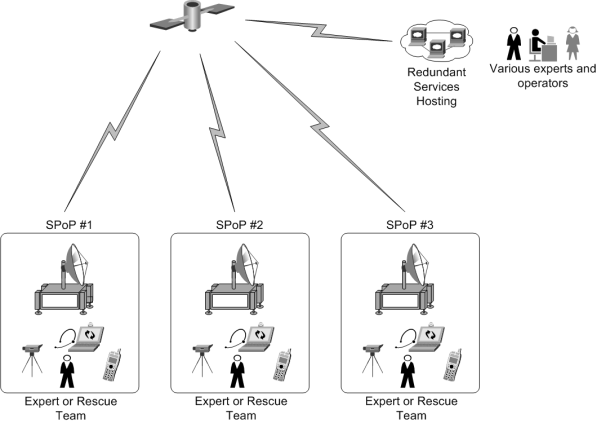
Figure 1: SPoP deployment
Receiving ample information can be a real add-on also for the analysis of the situation. Indeed, the collection of pictures, sensor information or video clips from the crisis site allows different experts, specialised in different areas, to make their proper analysis. For example, water quality specialists can receive in their laboratory the water analysis gained on site through sensors.
To efficiently collect this wealth of information, the NoSaCo terminals are also equipped with software for collecting information from the end-devices (cameras, sensors or computers), and storing and sharing it with the other SPoP or with the Service Hosting. This distributed architecture allows an advanced management of the resilience, security and quality of service, ensuring that the local collection and access to information is still possible even when no communication to the Service Hosting is possible. Once the communication is restored, synchronisation processes are sharing automatically the information with other SPoP and in the Service Hosting. The onsite experts or the operators do not have to take care of the technical elements and can focus on their primary mission.
Technical architecture and technologies
The technical architecture behind the Emergency.lu platform relies on three separate layers (Figure 2).
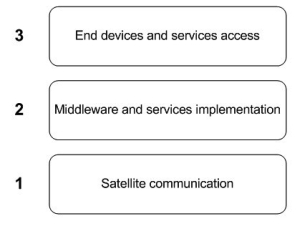
Figure 2: Architecture layers
Similar to the OSI layers, these layers provide different levels of abstraction, from the satellite telecommunication to the final delivery of a service to experts and other users.
Layer 1: Satellite communication
The overall telecommunication concept relies on the creation of three geographically distributed hubs. With the similarity to the OSI Layer representation, the Satellite communication layer can be compared with the physical layer. The hubs will maximize service availability and resource usage efficiency by implementing advanced techniques such as DVB-S2 / ACM and LDPC FEC coding on outbound, MF-TDMA and 2D 16-State coding on inbound. In addition, QoS management and TCP optimization will guarantee a good service experience to the end user.
From a satellite connectivity perspective, the teleports hosting the hubs are selected to enable up-linking to a designated subset of SES satellites that will provide a true global coverage. As presented in Figure 3, three hubs geographically distributed over the world give access to enough satellite beams from SES fleet in order to provide both C and Ku band global coverage.
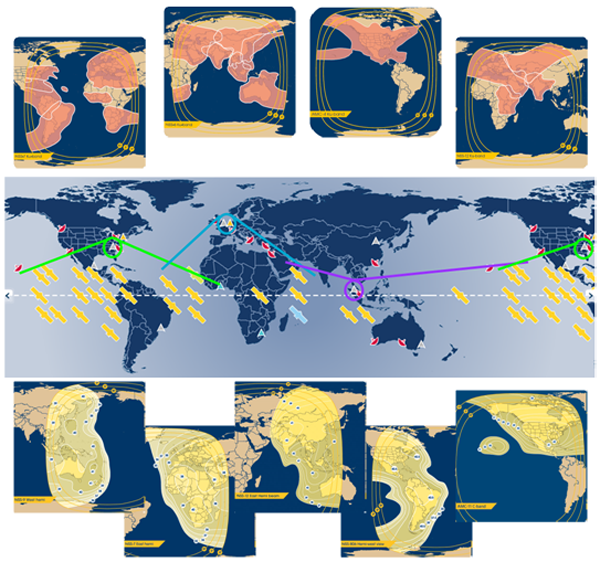
Figure 3: True global coverage (C band below – Ku band above)
This additional flexibility on the frequency side will allow tailored solutions from a link budget point of view. Furthermore, relying on a single satellite operator also brings economy of scale and allows for easy management of a global satellite service through a single interface.
From and between the teleports, IP connectivity will be ensured to the Service Hosting and the global Internet. Furthermore, the Internet connectivity allows the establishment of VPN (Virtual Private Network) connections and dedicated QoS (Quality of Service) for remote crisis centers, NGO headquarters or any other management entities. Security and privacy can be provided through encryption of the traffic. Additional security can be considered at application level.
On the crisis site, NoSaCo terminals are deployed on site to create an IP connection with the relevant hub. This connection will be used to create and deploy the service. The technologies implemented in the NoSaCo terminals are obviously highly tainted by the technologies implemented in the hubs. The main concept of these terminals is to integrate the modem into a compact, light weight and easy to deploy module. The compactness of the terminal will allow its transportation in small planes not requiring a long preparation time (Figure 4).

Figure 4: NoSaCo terminal
Layer 2: Middleware and services implementation
From a service layer point of view, the two hosting platforms are implemented in Emergency.lu to deliver the service to the users. The service implementation is however not only relying on the central hosting but on distributed service implementations (Figure 5). Each NoSaCo terminal is integrating a small part of the service allowing a local relay of the service. The direct advantage of this distribution is the possibility for the service to work whenever the satellite connectivity is present or not. A kind of off-line mode is created as a result.
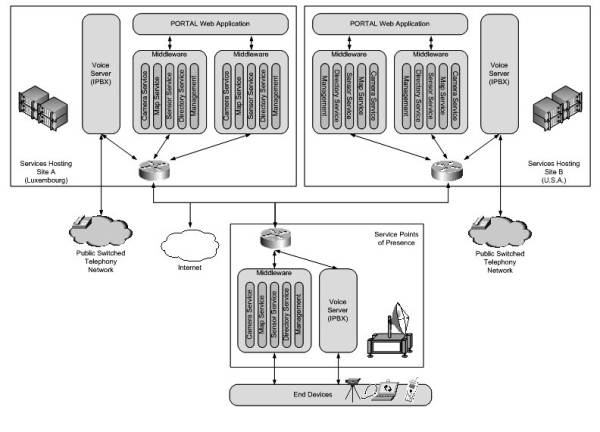
Figure 5: Service Architecture
The services supported and provided are basically:
- Voice communication using SIP based Voice over IP communication: Each Service Hosting is implementing an IPBX with dedicated connection to PSTN and offering a link to small IPBX implemented into the NoSaCo terminals.
- Camera Service: Collection and sharing of imagery and video streams provided by the included cameras or via manual upload.
- Map Service: Repository of tactical maps that can be accessed and drawn by different frontend applications.
- Sensor Service: Collecting, analysing (based on thresholds), storing, and sharing sensor data. Typical sensor information can be gas and pollution concentration, humidity or temperature. This service is also managing the dynamic localisation of entities provided currently by GPS.
- The Directory Service is managing the contact information that is used for voice communication as well as an inventory of devices or components and their logical organisation.
- The Management Service is finally the back end component that is taking care of tracking the other middleware nodes, the auto-configuration and the security of the information.
To ensure a convenient user experience, all services are using a self-discovery concept via IP multicast mechanisms and are directly managing their communication and synchronisation without any intervention from the users.
Layer 3: End devices and services access
To provide an intuitive access to the services, the NoSaCo terminals include a set of equipment that is used to collect information (Video cameras, sensors) or to directly interact with the services (Voice over IP phones, ruggedized computers). These end-devices are pre-configured to work with the NoSaCo terminal and, as a result, ready to operate in any place.
As stated before, the terminal has been implemented in order to facilitate its transportation and make its installation as simple as possible to anyone with a minimum amount of technical knowledge and skills. The use of the service is made as convenient as this, using intuitive, specifically designed applications.
For the usage on the crisis site, the ruggedized computers are equipped with a tactical application that is offering an access to the different services via a touch screen interface (Figure 6). This interface is using the gesture recognition, now popular in the mobile areas and specifically interesting for ergonomics. Touch screen interfaces are facilitating the handling of the applications as no pointing devices like mouse or trackball are required.
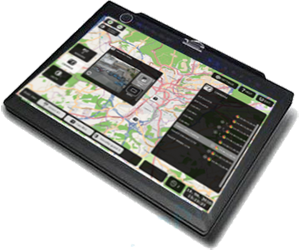
Figure 6: Tactical client Interface
On the other hand, in the crisis center or headquarters, a web portal can be used as user interface (Figure 7). The portal provides access to the same services (Voice, Video, Sensor, Maps and Directory). Relying on Web 2.0 technologies, it can be accessed from different places in the world like in laboratories or crisis rooms in different capitals.
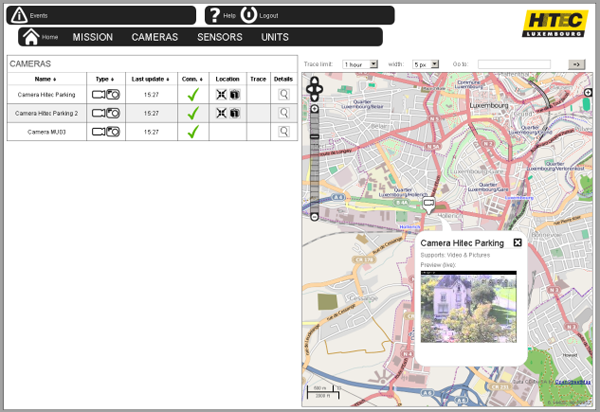
Figure 7: Portal Screenshot
Deployment scenarios and conclusion
As mentioned before, the Emergency.lu approach has been designed with the intention to improve the situation on two main levels: First, reduce the duration of transport of the very first teams to any major crisis scene and second, provide adequate communication means right from the beginning.
To meet these objectives, the consortium has decided to include air transportation in the solution. Through a fleet of LearJet’s, ready to leave Luxembourg within the hour, and with operational and medical staff on a 24 hours a day duty schedule on the airport, Luxembourg Air Ambulance (LAA) can ensure the required reactivity.
Although LAA has over 20 years experience in supporting disaster relief and humanitarian missions with fixed wing and rotor wing aircrafts as well as medical teams, this more global approach requires an impeccable planning involving all the partners. At the airport, a controlled storage is kept constituted by NoSaCo units, food and beverage to guarantee autonomy of the team for 15 days, basic medical supplies for the team and required logistic equipment (i.e. tents, generator).
Frequent trainings, exercises and pre-emptive maintenance are organised to maintain the Emergency.lu platform on a ready to operate status.
Besides the technical readiness, the qualification of personnel involved in these rescue missions is crucial. Procedures have been designed to optimize the collaboration between the different actors, and training is recurrently organised. For an optimal effectiveness of the team, the pilots have been trained to install and operate the NoSaCo installation on site. They are able to give instructions to the local teams and function as on-site support. All team members have received in depth crisis management education and have experience in disaster relief missions.
The emergency.lu intervention team is completed by one or more medical staff , with the primary objective to ensure the medical support for the crew and to support the medical assessment of the situation.
Finally, in best case, the unit is completed with one or more experts for needs assessment assigned by international organisations, i.e. UN (OCHA) or EU (ECHO/MIC). Through the network of partner operators in Europe, LAA can rapidly transport these experts from within Europe not to delay the departure of the mission.
It is very important to point out that the Emergency.lu solution is not intending to replace any existing mechanism or intervention teams, but that it should be seen as a valuable and helpful support. This service is planned to be offered to all international and national organisations. It has to be clearly stated that the solution will work hand in hand with known UN forces.
Once the system is deployed, it can be decided either to dissolve the unit and return to Luxembourg with the equipments, or one can consider building a more permanent communication infrastructure, potentially through an increased amount of NoSaCo units. This last option considers that the effort to support the on-site population in the first hours can also be maintained to assist in the reconstruction of local infrastructures.
